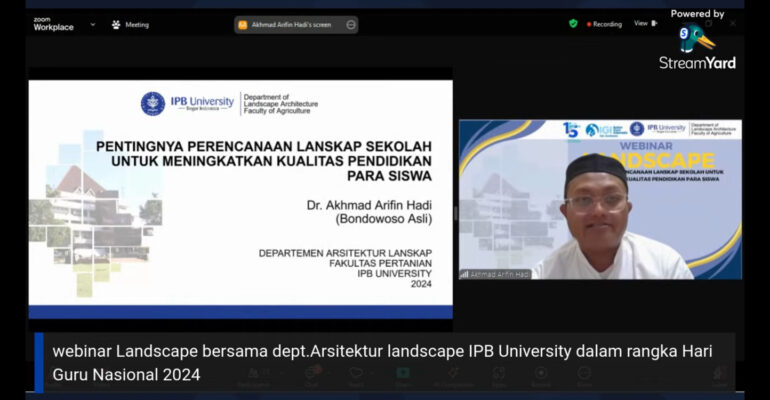IPB University Lecturer: School Landscape Planning is Important to Improve the Quality of Student Education

The Department of Landscape Architecture (ARL), Faculty of Agriculture, IPB University together with the Indonesian Teachers Association (IGI) Bondowoso held an online Landscape Webinar. In this event, Chairman of the ARL Department of IPB University, Dr Akhmad Arifin Hadi revealed the importance of careful planning in school landscape design.
“A beautiful school landscape can increase the enthusiasm for learning of students, teachers, support staff, and the community,” he said in the webinar held to commemorate National Teachers’ Day.
Indeed, he said, school landscapes are outdoor spaces in the school environment that are planned, designed and managed to support learning. Not only that, school landscapes also play an important role in social interaction, health and well-being of students and school staff.
“Landscapes such as green spaces, play facilities, circulation paths, learning spaces, social areas, and outdoor spaces must be made safe, comfortable, healthy, and memorable,” he said.
He pointed out that school landscapes in Japan, for example, are made uniform and with national standards.
“School landscapes in Indonesia do not need to take 100 percent external references, but are adapted to the macro climate, micro climate, culture, and student preferences,” he recommended.
According to him, the school landscape should be able to support the school’s learning culture, such as providing discussion areas, outdoor practice, art performances, and sports. Moreover, it must be planned and pay attention to the Occupational Health Safety and Environmental Management System (SMK3L).
“In addition, it must be adapted to its management capabilities, in addition to paying attention to function and aesthetics,” Dr Akhmad added.
He also shared insights on school landscape planning, especially in plant planting. Without good planning, it can actually pose various risks.
For example, blocking the view to important buildings, creating excessive overgrowth that increases humidity, and harboring mosquitoes. In addition, areas can become overly enclosed, damage the structure of the building, or even limit evacuation areas during emergencies.
“In the planning or landscape design stage, it is very necessary to analyze climate, land slope, hydrology, preferences, circulation, and views,” he explained.
For example, he continued, the design of the IKA Faperta IPB University Park. In addition to becoming a new identity for Faperta IPB University, the park is maximized with the addition of rain gardens and garden towers.
“School landscapes that have not been built need to be designed in the right stages, while those that have been built need proper management planning and implementation,” he concluded. (MW/Rz) (IAAS/NYS)



